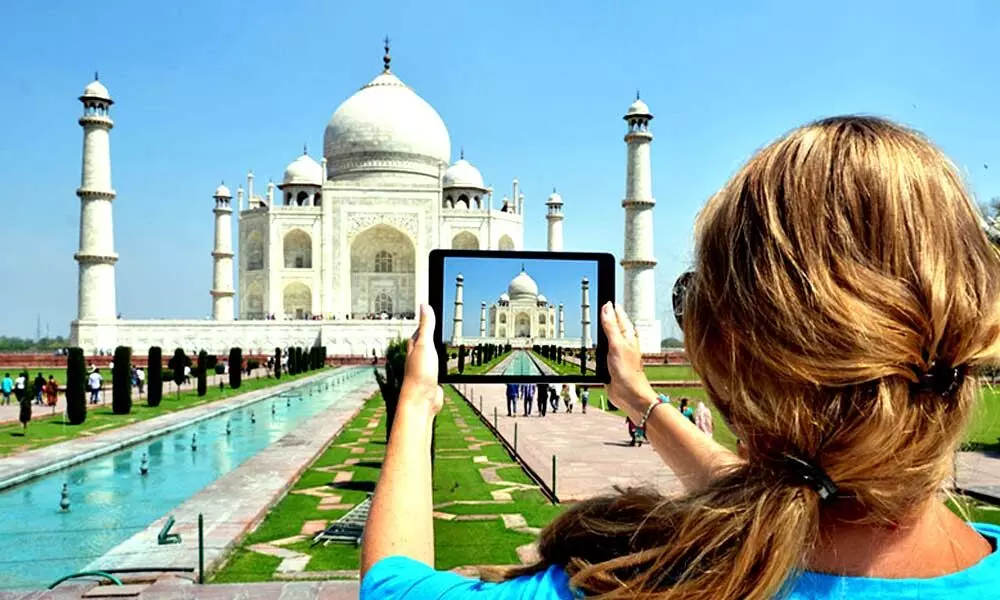India's tourism industry needs govt support for unlocking its full potential
In India, the Covid-19 pandemic only worsened a crisis that had already hit the tourism industry. In 2019, India recorded one of its worst years as a tourist destination. Arrivals of overseas tourists and the country’s foreign exchange earnings from them grew at the slowest pace in 10 years
image for illustrative purpose

Only a handful of States like Rajasthan, Gujarat, Goa and Kerala have been able to attract tourists and compete in an increasingly fragmented tourism landscape
From snowy mountains to sandy beaches, hilly terrains to serene lands; old ruins immersed in history to modern architecture, and national parks to bustling cities - India has something to offer for every kind of traveler.
Tourism's importance goes beyond its contribution to the economy. It is one of those pleasurable recreational activities, and reminds us how life should be. All of us need a vacation at various points in life. Tourism contributes about 5.07 per cent to GDP (Gross Domestic Product) and offers about 90 million jobs. In 2019, international tourists visiting India contributed $33 billion to the economy. There are some other important figures to note: Around 1.4 billion domestic visits were made, out of which 60 per cent can be religious, historical, and cultural. Domestic tourism is crucial for India. Tourism covers a wide spectrum - from heavy investment sectors such as civil aviation, railways, road transport to smaller ones such as bed-and-breakfasts, dhabas.
The website of 'Incredible India' has also been updated in multiple languages like Chinese and Arabic to facilitate a smooth flow of communication across multiple countries. Initiatives like SATHI (System of Awareness Training for Hospitality Industry), SWADESH and the Incredible India Tourist Facilitator (IITF) Certification Programme have been launched. The programmes aim at enhancing the overall experience of tourists by creating a pool of talented and skilled individuals in the travel, tourism and hospitality industry.
The Indian Government also supports Indian tourists for visiting Maldives and has played an important role in making it the next door travel destination. By the end of this year, more than 3,00,000 Indian tourists are expected to visit Maldives which is a highest recorded number for any country. Indians are hard-working individuals, be it IT professionals, doctors or executive class - they all need a vacation break, and we are working to kick-start our North airport which will cut the travel time by 45 minutes for Indian tourists. Very soon Maldives is all set to become the first country to initiate Vaccine Tourism called as "3V"- "Visit, Vaccinate and Vacation"; it will give travelers the option to get vaccinated against Covid-19 in the Maldives and promote it as a safe destination for tourists.
Nepal was preparing to launch Visit Nepal Year 2020 and focusing on that a number of new tourism activities and new products were introduced in Nepal. But before we could publicize it to the world the pandemic struck. Nepal is now open to tourism, especially for the Indians, and is also easily accessible from several border points by road along the Indo-Nepal border."
In Services Exports Promotion Council (SEPC), hospitality and tourism is the largest sector from amongst the 12-13 champion sectors. No country can ever grow unless it has a very vibrant and strong hospitality industry and today India has one of the finest hospitality industry in the world.
In the current times, states like Jammu & Kashmir, Uttarakhand, Kerala and Goa have seen multifold inbound traffic. Tourism is a resilient industry, an industry which can and will help itself nurture and grow. SATTE (South Asian Travel and Tourism Exchange) refocused its strategy this year, focusing primarily on the domestic market and a few exclusive international destinations that have opened their doors to tourists since the lockdown was lifted or are looking at wooing Indian stakeholders once restrictions are eased. These included participants such as AlUla, Nepal, Maldives, Malaysia, Utah and Expo2020 Dubai.
In India, the Covid-19 pandemic only worsened a crisis that had already hit the tourism industry. In 2019, India recorded one of its worst years as a tourist destination. Arrivals of overseas tourists and the country's foreign exchange earnings from them grew at the slowest pace in 10 years. In 2019, just 10.9 million foreign tourists visited India. In the same year, Vietnam, a country just slightly larger than Maharashtra in size, had 18 million foreign tourists visiting.
The real reasons for the country's shockingly low tourist numbers are apathy, terrible heritage management and the inability to provide even basic tourist infrastructure at heritage sites.
Despite our great history, monuments and arts, and the pride we take in our heritage, the central and State governments have done precious little to promote our heritage, even to Indians. Only a handful of states like Rajasthan, Gujarat, Goa and Kerala have been able to attract tourists and compete in an increasingly fragmented tourism landscape.

